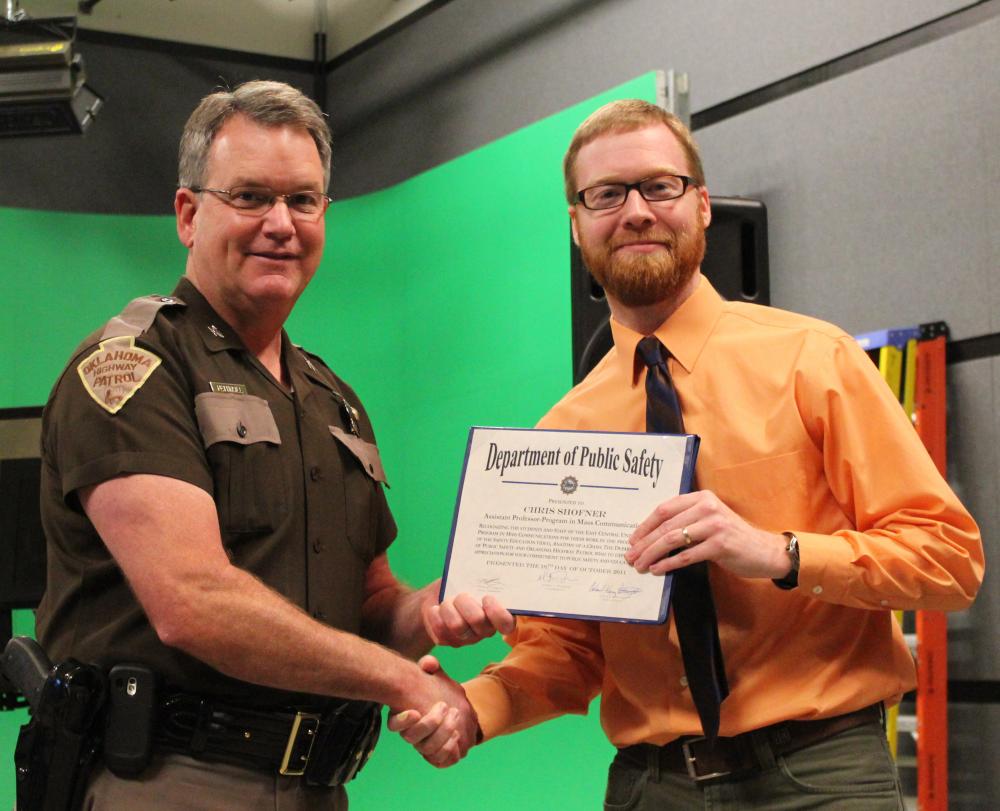The biggest misconception about a car crash? That there’s only one collision.
There actually are three, and the last two directly affect your body and brain, not your vehicle, often with deadly consequences.
Capt. Ronnie Hampton, troop commander of the Oklahoma Highway Patrol Troop F, based in Ardmore, wanted people to realize what can happen in a crash if they don’t wear their seatbelts, so he turned to mass communication students at East Central University for some assistance.
“Our goal is to get people wearing their seatbelts,” he said.
In a crash, for example, the second collision occurs when an unrestrained person, still moving forward from the first collision, hits the steering wheel or windshield. The third collision is the front of the brain hitting the front of the skull, then bouncing to the back of the skull. The real damage comes when the brain twists on its axis.
Since seatbelts reduce the odds of dying in a crash by 65 percent, Hampton said he started looking at ways to educate the public why they should use them along with air bags.
“We had a lot of (educational) videos, but they were outdated. Most were black and white and had cars from the 1970s.”
Hampton approached ECU about making a new video because he knew former ECU vice president Dr. Steve Turner through the Council on Law Enforcement Education and Training (CLEET) in Ada. That’s how Hampton met Chris Shofner, ECU assistant professor of mass communication, who guided 12 students through the project last summer.
The result – the 18-minute video “Anatomy of a Crash” makes a powerful case for fastening seatbelts.
“Right now, we want to get it out and get it seen by as many people as possible,” Hampton said. “Through education and enforcement, we hope to increase seatbelt usage.”
The video illustrates how Delta V, or a change in velocity, leads to injury. It alternates between comments by Hampton, a 17-year-old driver who suffered severe injuries because she did not buckle up, and a neuropsychologist who explains how brain damage occurs as long as 24 hours after the crash.
Originally, DVDs were given to all 31 OHP troopers in the seven counties in Troop F (Carter, Love, Garvin, Murray, Pontotoc, Johnston and Marshall) to show at schools, businesses or wherever they might be asked to speak. Later, troopers in Coal, Atoka, Bryan, Pushmataha, Choctaw and McCurtain Counties in Troop E received the DVDs.
“We’ve probably touched 200 to 300 people in the last year,” Hampton said.
The Highway Patrol and the Highway Safety Office are working on a statewide crash reduction plan, Hampton said, and he expects the ECU-produced DVDs will be in all 77 counties in 2013.
The video can be viewed on YouTube at http://youtu.be/O_nNeO_TeYI.
“This is just another piece of how we try to reduce crashes. We can’t stop them. They’re going to happen anyway,” Hampton said, “but we want to make sure people who might have died are only injured, and those who are injured aren’t hurt as bad.”
The largest showing of the DVD was in May just before graduation at Durant High School.
“They asked anyone to come in who would be driving in the next 12 months and all those who already have driver’s licenses,” Hampton said. “It was a lead-in to a presentation on drunk driving.”
The video was “premiered” at ECU last October for Michael Thompson, the commissioner of the Department of Public Safety; Col. Kerry Pettingill, chief of the Oklahoma Highway Patrol; Maj. Barry Ross and Hampton when they came to ECU to express their appreciation to administrators and the students who worked on the project.
After initial meetings with Hampton to determine what the finished project would be, Shofner said his students “really took the lead. They did all the work. That was what impressed me the most. I just kept everything together and on schedule.”
Students who produced the video were Anthony Bowie, Ryan Corley, Joe Cregger, Matt Hamilton, Shannon Littlefield, Nathan Palmer, Wyas Parker, Donna Ray, Caprest Rhone, Jacob Sircy, Maddie Wilson and Kim Wren.

